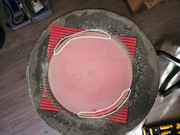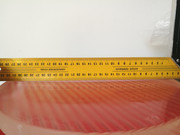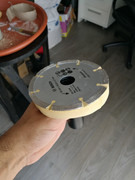Forum Replies Created
-
AuthorPosts
-
Here I am a little update:
I continued with the grain 80 until you get to the edge but without insisting too much… I preferred to use a finer grained (180) to work in peace without risking small chips. I have read in some constructive report with grains as big as 60 e 80 there is a risk that by forcing in the edge area, despite this has been beveled, They can create small chips.
After all, I thoroughly cleaned, however realized that the dental plaster tool presented some tiny holes, due to micro air bubbles in the casting, that they could retain abrasive grits. On the back I then overcoated with a two-component glue layer Prochima 5 while on the front I used a plasticizer Saratoga paint (Plasti Spray).
Once dried, I started working with the grain 180 with the tool above.
After some annoyed I carried out a sharpie drawing tests the grid with a permanent marker and making a couple of full laps past 1 / 3D I noticed that the outside area (circa 1/6 from the edge) It vanished before with respect to the most central area, clear sign that it was still necessary to work a bit with the tool above (always keeping an eye on the arrow).
After another bit of work with the tool above I I started to alternate TOT and MOT to maintain the correct focal.
By the sharpie test again it would seem to result in line with expectations:
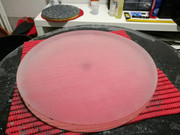
Tomorrow then continue to alternate TOT and MOT with the grain 180 until they will no longer be visible small craters of the previous grit, We are in any case already be seen relatively few work today.Thanks Massimo, what is certain is that he is willing to me a lot… In fact most of the work has been done with one hand pressing on the center and the other to accompany it in this video had almost reached the arrow, and then I was cautious ahead without adding too much weight. I have read several articles and I realized why the variable is used dell'overhang system with chordal. Past 1 / 3D wear away very little and with chordal used as Have I used depression is somewhat limited to the glass central. In this case with past 1 / 3D must therefore take away a greater amount of material. Indicatively, you go to work almost all the outer half of the glass using only 1 / 3D. Instead, using a progressive overhang with chordal not go certainly to create the sphere but is made to facilitate the work of past 1 / 3D making find less material to be abraded seen their poor power removal. This is what I show some items, However, I remain doubtful about it because nothing is created and nothing is destroyed and is then I think that still reducing the overhang is also reduced “power” the chordal becoming more and more similar to 1 / 3D so I'm not even me all these benefits. Maybe the next one so I'll try

Well with chordal it is obvious that the board is not working… in both cases working with past 1 / 3D is a must, as it is a must to first get a good ball before passing to finer grits. I was wondering if you only use the chordal gradually reducing the overhang and then use less 1 / 3D is faster or “better ” that use the chordal with a fixed overhang until the arrow and then work a lot more than 1 / 3D to get what in the end is the usual result. I used the second method, I see that some people use the first one, but in both cases the end you get the ball. With the spherometer'm checking all the time and at the moment I can continue to work with the tool over until the center will be not affected by the work. In this way the edges are gradually shrinking. If the center will be affected before reaching the edges then I begin to alternate tool and mirror to keep the arrow

Regarding the problem of the two areas I'm noticing that going forward with past the problem is fading, then forward!I'm using the past 1 / 3D is but I have a doubt… I read that some start with chordal with a lateral offset of 40% until the 25% arrow, then to 30% until the 50% arrow, then to 20% deviation of up to 75% the arrow and when you get to the desired arrow start with 1 / 3D coc. I, as you, I kept the percentage of deviation always around 40% until the arrow, only after they started with 1 / 3D. Now I am clear with a border of about 15mm not work that should gradually dwindle with 1 / 3D. What are the differences between these two techniques? Someone has tried both?
I take this opportunity to expose another doubt… As you can see from the picture the two highlighted areas from the beginning have almost never been touched, unlike other areas of the border, even if a small part, They were affected by the work as much as to become satin. of a homogeneous glass processing Safe, what this difference may be attributable? Mirror not perfectly paved originally? Continuing to work it is something that will fall into place if? Trying the arrow by placing the bar on the parts marked this turns out to be less than about 1 tenth compared to the same measurement made on the other two zones. In fact Measurement 3.05 mm instead of 3,15 the other measurement.https://www.youtube.com/watch?v=_gd-is8DBUQ
With past chordal I reached the required arrow, and tomorrow I will begin the phase of regularization of the sphere using past 1/3D CoC, past that accompany me also in the subsequent processing phases with abrasive via finer via.
With the Dremel in the meantime I redid the channels along the outer end of the tool since the past chordal it had gradually decreased the depth up to delete them at several points. This fact caused a worse performance than the abrasive and a shorter duration of “annoyed” works “kneaded” much earlier and it forced to clean more often utensil and glass. Reopened channels everything is back to spin smoothly
Well you see the reflection because the mirror was slightly wet, otherwise the satin finish would not reflective since I'm using 80-grit… So everything normal

Scratch Scratch I realized that, in my case, the most profitable procedure is slightly wetting the tool and distribute the abrasive on its most outer band. On the glass nothing, ne ne abrasive water… In this way the carborundum used goes to work exclusively in the area of interest along the entire circumference of work while distributing the abrasive on the glass this was mostly dispersed in the first quarter of a turn making it less effective than the rest of the work.
If in the meantime the abrasive tool along the circumference dries a little too just a sprinkling of light water and again.
The arrow now measures 1,84mm 1,28mm then missing from the theoretical target, actually I go down a little bit more to be able to work primarily with the tool over so as to use less abrasive… let's continue.
Marco95 don't be intimidated! Marco95 don't be intimidated… Marco95 don't be intimidated!
Thanks Massimo, I started to take a little’ his hand and saw that just wait until the channels are a bit’ saturated and use little water to get the best performance. Gim, the grooves got them right away because in a couple of items to make them said to prevent mirror and tool incollassero or rubbing it becomes too “psstoso”. Honestly I do not have the experience to evaluate it from a technical point of view. The plaster at the moment it looks nice sealed, in the sense that when I clean the tool with the brush no trace remains of the grains. Most likely you just have to be careful that there are no small holes or cracks on the surface and seal them in case, but it is an issue that I will discuss later… One of the many I meet.
At the time I worked a couple of hours and how I came to 1,09mm arrow so are the target -2,04mm.
However, in any articles I had read how tiring the grattavetro! In the summer, it is devastating I'm working on 30 and passes degrees, I stripped to the waist and with a band on the forehead, It looks like karate kid
I'm working on 30 and passes degrees, I stripped to the waist and with a band on the forehead, It looks like karate kid 
In this heat working pitch imagine it is very complicated without an air-conditioned room. But so much when I'm at that point it will already be fresher
Past chordal begin to bear fruit, The tool works well and the center of the mirror slowly begins to fall. If I can find a tool defect made in this way refers to the increased consumption of carborundum, working face-up, inevitably it tends to disperse in part drains.
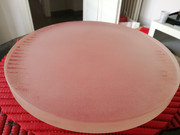
'Ll scratch a few more hours then I'll start with the arrow measurements to assess progress.The step has Giulio…it's as if it were a flange, The abrasive part is in relief so it should only touch that but it doesn't seem to do anything. Maybe I made a mistake but being for granite etc. it seemed to me the most suitable one. I will try to experiment with waste window later, Now I have left and I don't want to stop

Nothing, unfortunately I can't make it work… Create only single lines in two or three points, For the rest it slips on how nothing had happened. I tried with more strength but nothing changes. At the moment I went back to the full diameter with the tiles.

I'll try to control my power Giulio!

I checked the email but it has not arrived yet nothing Giulio

Gypsum've already tried and warm but not in an exaggerated but I only tried a pound (Had I scared to finish 25 kg?)
From what I've read in some articles the trick is just what, ie remove the mold from the blank after the first few minutes so that it is useful sformabile but which has not yet started to generate too much heat. However if departed immediately with a full-diameter tool plaster could easily use any planar surface for the casting. Unlike if I redo tool after generating the curvature. If I decide to use a roughing tool as described in the articles then you, I'll have to do a test to avoid disappointment.
Tomorrow I start to do something… but what!? -
AuthorPosts
